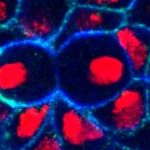About
For many developmental processes, the list of the required elements (genes/molecules) is known but the resulting dynamics is often poorly understood. Thus, in most developmental patterning processes, the relative importance of external positional cues and self-organization remains an open question. Sensory bristles on the Drosophila epidermis are a classic model for cell fate patterning. Lateral inhibition via Notch selects sensory organ precursors (SOPs) within “proneural clusters”, groups of cells expressing genes of the achaete-scute complex. In the dorsal thorax, a number of bristles develop at invariant locations, defined by a genetic prepattern, and a series of proneural stripes gives rise to regular rows of finer bristles. Using a combination of mathematical modeling (with F. Corson, ENS Paris) and live imaging, we have shown that Notch activity negatively defines where proneural activity can emerge in the developing thorax, and that self-organization involving cell-cell interactions mediated by Notch directs patterning dynamics at the tissue scale. Thus, Notch signaling not only selects the SOPs within each proneural stripe but also organizes the stripes themselves, whereas positional cues seem to only define the initial and/or boundary conditions that guide self-organized Notch dynamics. We are currently investigating whether this model applies to other developmental contexts.
F. Corson, L. Couturier, H. Rouault, K. Mazouni and F. Schweisguth (2017)Self-organized Notch dynamics generate stereotyped sensory organ patterns in Drosophila. Science 356, 501, eaai7407
L. Couturier, K. Mazouni, F. Corson, F. Schweisguth (2019) Regulation of specific E(spl)-HLH genes by proneural factors shape output dynamics during bristle patterning in Drosophila. Nature Communications, 10: 3486
Reviews:
F. Schweisguth and F. Corson (2019) Self-organization in pattern formation. Developmental Cell, 49, 659-677



